|
In this Issue...
- Letter from the IBNS Editor-in-Chief
- Photo contest and Symposia announcement
- Diversity and Ethics Committee
- Trends in Science: Nobel Prize
- IBNS Career Center
- Graduate Education and Mental Health
- IBNS 2020: Upcoming Meeting Deadlines
Letter from the IBNS Editor-in-Chief
The new Editor-in-Chief of the IBNS Newsletter…that sounds a bit daunting and it is. More on that later. To begin, let me introduce myself - my name is Don McEachron and I am a Teaching Professor in the School of Biomedical Engineering, Science and Health Systems at Drexel University where I have been since May 4, 1984 (that is a bit daunting as well!). I am also a Fellow and Founding member of the International Behavioral Neuroscience Society. I was asked to take this opportunity to present my vision for the IBNS Newsletter but first – and far more important – I would like to express my appreciation – and that of the entire IBNS membership – to Dr. Davide Amato for his tireless effort, extraordinary dedication and inspired leadership as Editor-in-Chief of the IBNS Newsletter. His will be a very difficult act to follow and I hope that the membership of IBNS will be patient as I attempt to grow into this position.
Now, to the vision. I have to admit that I am not sure how to respond. With any group of people who are united by discipline but separated by geography, it is difficult to maintain a true sense of community. Our local environments and the individuals within them naturally tend to dominate our thinking and perspectives due to their proximity, making the more distant relationships harder to sustain and grow. And yet, an international society needs that sense of relationship and family among its members to function as a true learning community. One major method to sustain such a sense of community is the Annual Meeting – this is like homecoming, class reunions and the holidays all wrapped up in one event. However, as a single event, it is a bit much to ask the Annual Meeting to sustain our community for the entire year. Hence the IBNS Newsletter, which serves as one of our community’s methods of keeping in touch and sustaining our sense of family.
So, how does – or could – the Newsletter serve in this capacity? Well, how does a family sustain its members? First, by the simple act of communication – by saying I am here and I am interested. Thus, I think that it would be reasonable if the Newsletter had a letter section – a place to make inquiries, report events and make comments about ongoing activities related to the discipline. Interviews with IBNS members is another on-going activity that would help sustain a sense of family. Major events – awards, achievements, ground-breaking publications by IBNS members – should also be given a special place in the Newsletter. Second, families help one another with the various challenges of life. Related to this element, updates on research trends and opportunities is another element which has been incorporated in the past and should be sustained. I also think a mentoring section – monthly advice for graduate students, post-docs and your investigators – would be an important section to maintain.
Most of these elements are, or have been, part of the IBNS Newsletter and will hopefully continue to be moving forward. And that brings me to a critical realization – it is not my vision for the IBNS Newsletter that matters – it is the collective vision of the IBNS membership that is essential. My role is to carry out your collective vision – to help with the logistics and processes that create an effective IBNS Newsletter. However, what makes that Newsletter effective depends on you – the IBNS membership. It is only by articulating your vision to me that I can hope to carry it out. I therefore request that anyone with an idea about how to make the Newsletter effective send that suggestion to me. I will collect these suggestions, try to create a collective vision, and then do my best – with your help – to carry it out.
Yes, the role as Editor-in-Chief can be very daunting. However, with you help, I think the IBNS Newsletter can continue to be an important instrument to promote the IBNS family. Thank you in advance for your assistance.
Don McEachron
Editor-in-Chief, IBNS Newsletter
Back to Top
Photo Contest and Symposia Announcement
By Julianne Jett, Ph.D., Guest Editor
University of Texas Health San Antonio, USA
If you visited the IBNS booth or reception at the Society for Neuroscience meeting this year you may have noticed a kilted fellow named Jamie hanging around. To celebrate the upcoming IBNS Annual Meeting in Glasgow, Scotland, IBNS held a photo contest in which contestants shared their selfies with Jamie online for friends, family and colleagues to vote on. The prize for the photo with the most votes was a free annual membership to IBNS. In the end, the top 2 photos were so much fun that IBNS awarded membership to both! A big congrats to Hadley Drozd for her photo titled ‘Head over heels for IBNS!’ and to Keith Feigenson for his photo titled ‘The standard literary hunk. And Jamie.’ We hope that winning a free IBNS membership gets you one step closer to attending IBNS 2020.
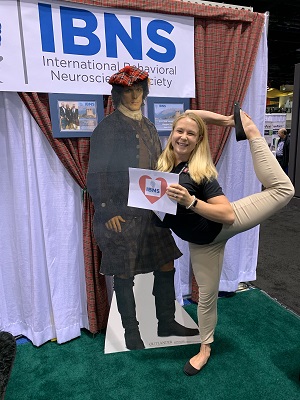 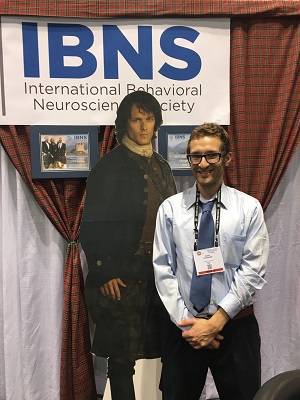
Congratulations to photo contest winners Hadley Drozd (left), a MD/PhD student at the Indiana University School of Medicine, and Kieth Feigenson (right), an Assistant Professor of Psychology at Albright College.
Similar to our photo contestants, many attending the IBNS reception could not resist the opportunity to snap pictures with our guest of honor. Excitement for the upcoming meeting in Glasgow was also celebrated with the official announcement of invited lecturers and symposia for IBNS 2020. This year’s lineup of invited speakers includes Stan Floresco (Presidential Lecturer), Tracy Shores (Bench-to-Bedside Lecturer), Christian Keysers (Keynote Lecturer), and Elizabeth Tunbridge (Keynote Lecturer). Additionally, IBNS 2020 will showcase a dynamic range of research topics at 34 symposia. Congratulations to those with accepted proposals - We look forward to learning more about your research in Glasgow! For a complete list of lecturer and symposia titles visit the IBNS website:
https://www.ibnsconnect.org/ibns-2020-annual-meeting
https://www.ibnsconnect.org/assets/images/2020AnnualMeeting/Symposia2020.pdf
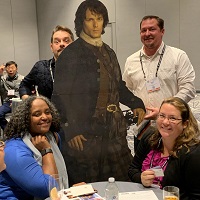  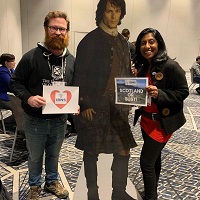
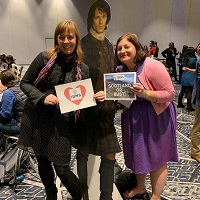 
Back to Top
Diversity and Ethics Committee: Science Outreach Across the Globe
By Millie Rincón-Cortés, Ph.D., Postdoctoral Fellow
University of Pittsburgh, USA
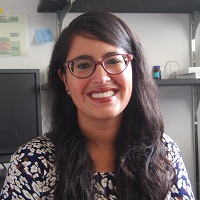 At the Cairns 2019 meeting, the IBNS Diversity and Ethics Committee kicked off its inaugural year with the goal of increasing diversity within IBNS. This committee resulted from the recognized need to highlight and put forth diversity in STEM by promoting and encouraging diversity within IBNS at all levels, which is based on the belief that diversity in science is vital to scientific advancement and a priority for IBNS. Indeed, the spirit of IBNS has always been to encourage science outreach across the globe, to bring science to every corner of life, and in doing so, enhance our understanding of science for everyone. For this reason, we are committed to welcoming people from all walks of life, irrespective of socioeconomic background, ethnicity, sexual orientation, gender status, mental health status, able bodiedness, national origin or political views; and, this welcome encompasses full participation in IBNS at every level (i.e. inclusion). Moreover, this commitment to enhance diversity and inclusion is also cognizant of the changing culture of educational/academic institutions and the awareness that our definitions of inclusivity may be expanded over time to reflect a changing world. It is with this awareness that we pledge to work towards maintaining a sense of belonging and security/safety for all members in our community. At the Cairns 2019 meeting, the IBNS Diversity and Ethics Committee kicked off its inaugural year with the goal of increasing diversity within IBNS. This committee resulted from the recognized need to highlight and put forth diversity in STEM by promoting and encouraging diversity within IBNS at all levels, which is based on the belief that diversity in science is vital to scientific advancement and a priority for IBNS. Indeed, the spirit of IBNS has always been to encourage science outreach across the globe, to bring science to every corner of life, and in doing so, enhance our understanding of science for everyone. For this reason, we are committed to welcoming people from all walks of life, irrespective of socioeconomic background, ethnicity, sexual orientation, gender status, mental health status, able bodiedness, national origin or political views; and, this welcome encompasses full participation in IBNS at every level (i.e. inclusion). Moreover, this commitment to enhance diversity and inclusion is also cognizant of the changing culture of educational/academic institutions and the awareness that our definitions of inclusivity may be expanded over time to reflect a changing world. It is with this awareness that we pledge to work towards maintaining a sense of belonging and security/safety for all members in our community.
Some of the steps that we have taken to increase diversity within IBNS include: specialized travel awards for underrepresented minorities (URMs), opportunities to develop mentor-mentee relationships at the IBNS annual meeting and within science in general, striving to achieve gender diversity in leadership roles and speaking opportunities (i.e. symposia, panels, keynote lectures), and drafting a Code of Conduct for upcoming IBNS meetings, among others. Furthermore, IBNS also provides discounted membership rates for +100 countries that are underrepresented in the IBNS community (see link below for complete list). Finally, since the work of the Diversity and Ethics Committee will span many areas within the IBNS, members of this committee have been placed in other IBNS committees to ensure that there is always a voice that highlights diversity and inclusion. We look forward to continuing to work for you!
Back to Top
Trends in Science: Nobel Prize in Physiology or Medicine 2019
By Liubov Kalinichenko, Ph.D., Postdoctoral Fellow
Friedrich-Alexander-University Erlangen-Nürnberg, Germany
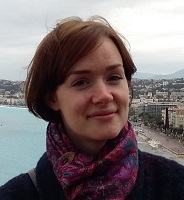 Oxygen is essential for animal life, as mitochondria present in practically all animal cells need oxygen for the conversion of food into ATP. However, how cells adapt to changes in oxygen levels has long been unknown. This year, a trio of researchers, William Kaelin (Dana-Farber Cancer Institute in Boston, Massachusetts), physician-scientist Peter Ratcliffe (University of Oxford, UK, and the Francis Crick Institute, London, UK), and geneticist Gregg Semenza (Johns Hopkins University in Baltimore, Maryland), won the Nobel Prize in Physiology or Medicine “for their discoveries of how cells sense and adapt to oxygen availability”. They showed that cells respond to changing oxygen levels by switching certain genes on and off. This discovery might be crucial for understanding certain human diseases such as cancer and anemia. Oxygen is essential for animal life, as mitochondria present in practically all animal cells need oxygen for the conversion of food into ATP. However, how cells adapt to changes in oxygen levels has long been unknown. This year, a trio of researchers, William Kaelin (Dana-Farber Cancer Institute in Boston, Massachusetts), physician-scientist Peter Ratcliffe (University of Oxford, UK, and the Francis Crick Institute, London, UK), and geneticist Gregg Semenza (Johns Hopkins University in Baltimore, Maryland), won the Nobel Prize in Physiology or Medicine “for their discoveries of how cells sense and adapt to oxygen availability”. They showed that cells respond to changing oxygen levels by switching certain genes on and off. This discovery might be crucial for understanding certain human diseases such as cancer and anemia.
It is well known that rapid adjustment of cellular conditions to the amount of available oxygen determines metabolism in almost all animal cells. Cell oxygen levels may significantly vary during normal physiological events (drops in available oxygen in skeletal muscle during exertion, for example) as well as in pathological processes such as cancer and infection. The molecular signal pathways controlled by oxygen affect more than 300 genes of various regulatory networks, which contribute to numerous physiological processes from organ development and metabolic homeostasis to tissue regeneration and immunity, and play key roles in many diseases, including cancer.
Starting from 1990s, the research groups of Gregg Semenza, William Kaelin and Sir Peter Ratcliffe have been studying the molecular processes determining cell response to oxygen levels in the body. They found the key mechanism of these processes involving proteins called hypoxia-inducible factor (HIF) and von Hippel–Lindau tumor suppressor (VHL). First, Semenza and Ratcliffe studied the regulation of erythropoietin, which stimulates erythrocyte production as a response to low oxygen levels. Semenza identified the genes encoding the two proteins forming the protein complex HIF. One of these proteins, HIF-1α, was shown to regulate of oxygen responsiveness in the HIF complex.
Kaelin studied a tumor suppressor gene VHL, which mutations are associated with a genetic predisposition to certain cancers. Together with his collaborators, Kaelin observed the interaction between HIF response and VHL-linked tumorigenesis, as well as the potential link between VHL and protein degradation.
Ratcliffe and his team later found that VHL gene encodes the protein, which interacts with HIF-1α and induces its destruction once oxygen levels rise. Kaelin and Ratcliffe then observed the specific chemical modification of the VHL protein, called prolyl hydroxylation, which in presence of oxygen allows VHL to bind to HIF leading to its breakdown. However, this modification is blocked during the lack of oxygen, kick-starting the activity of HIF. The identification of this modification regulating HIF-1α stability gave rise to the possibility of creating specific inhibitors of prolyl hydroxylase in order to increase HIF activity. Pharmacologically increased HIF function may be beneficial for the treatment of a wide range of diseases, as HIF is shown to be essential for immune function, cartilage formation, and wound healing. Enhanced HIF levels have been shown in many cancers as well as in some cardiovascular diseases, including stroke, heart attack, and pulmonary hypertension.
References:
1. https://www.nobelprize.org
2. Nature 574, 161-162 (2019). doi: 10.1038/d41586-019-02963-0
Back to Top
IBNS Career Center: Connecting talent with opportunity
By Julianne Jett, Ph.D., Guest Editor
University of Texas Health San Antonio, USA
Whether you are a postdoctoral fellow looking for your next professional opportunity, a principle investigator searching for the right candidate to complete your team, or an academic department in need of educators passionate about mentoring future scientists, the IBNS Career Center can assist. So what makes the IBNS Career Center (http://jobs.ibnsconnect.org) different from other job boards (e.g., HigherEdJobs, Indeed)? One vital factor, the resources it provides to applicants and employees are specific to careers in scientific research.
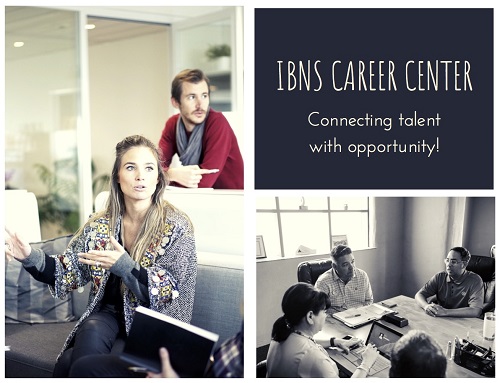
For job seekers specifically, the Resources section has a wealth of valuable tips from experienced scientists on resume building, effective communication skills, and do’s and don’ts for the interview process. You can also access advice for building your social media ‘brand’, which will help strengthen your professional online image and get the attention of those hiring.
The IBNS Career Center also benefits employers by providing free access to a large bank of resumes and profiles. This resource allows employers to customize their search by utilizing filters specific to their organization or lab’s needs and then creates a list of candidates that fulfill their search criteria. Additionally, the cost to advertise jobs through the IBNS Career Center (powered by Communitybrands) is cheaper than other job boards thanks to IBNS member discounts. Who can argue with saving money?!
Be sure to check out the IBNS Career Center to see what this valuable membership resource can offer you. For additional information, please contact the IBNS office at [email protected].
Back to Top
Graduate Education and Mental Health
By Julianne Jett, Ph.D., Guest Editor
University of Texas Health San Antonio, USA
No one is surprised to hear that earning a Ph.D. is extremely challenging. As the adage goes, “if it were easy everyone would do it and anything worth doing is hard work.” However, growing evidence of a mental health crisis in graduate education suggests that there is more to scientific and professional success than hard work1,2. Published this month, Nature’s biennial Ph.D. survey found that excessive focus on measures of success (e.g., publications, citations, funding, and impact), work-place aggression (e.g., bullying, harassment, discrimination), and exhaustion (e.g., poor work-life balance, uncertain job prospects) are issues contributing to job dissatisfaction and poor mental health amongst graduate students2.
Nature’s findings echo an earlier study by Evans et al. (2018) in which clinically validated scales of anxiety and depression were used to assess 1) the mental health status of trainees across graduate programs and 2) factors contributing to poor mental health in the graduate population. Using a convenience sample, they found that graduate students were 6 times more likely to experience poor mental health than the general public1. These results were alarming and rightfully prompted discussions about intervention strategies on social media and at conferences. But, have these discussions translated into improved mental health resources or training on campuses?
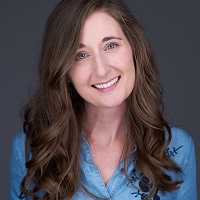 I recently followed up with lead author Teresa Evans, Ph.D., to get her insight on what actions have been taken (or can be taken) to improve mental health at the program or organizational level. Teresa is the Chief Operating Officer for Trauma Insight and an Assistant Professor at the University of Texas Health San Antonio. I recently followed up with lead author Teresa Evans, Ph.D., to get her insight on what actions have been taken (or can be taken) to improve mental health at the program or organizational level. Teresa is the Chief Operating Officer for Trauma Insight and an Assistant Professor at the University of Texas Health San Antonio.
What events motivated you to investigate the mental health of graduate students (MS and PhD)?
When I was the Office of Career Development at the University of Texas Health San Antonio, I found that students visiting me for career development advice would often show symptoms of a mental health issues. As someone who transitioned from my graduate training into academic leadership and a mentoring role, I had no training on how to identify and assist students in need of help. For example, I often found that I was unsure of how to interpret the degree of mental health support a trainee needed. Additionally, I was not sure if these mental health issues were specific to my institution or more widely seen. When I reached out to colleagues across the US, they voiced similar concerns and yet solutions weren’t being discussed on a larger stage because studies comparing graduate student mental health across programs hadn’t been conducted. This laid the foundation for my colleagues and I to design and conduct this study with the primary goals to 1) investigate if a trend existed and 2) with data in hand, catalyze a conversation about how to change academic culture to support graduate student mental health.
Your study had respondents from 26 countries. Did you find differences in the mental health status, specifically the prevalence of anxiety and depression, of graduate students from different nationalities?
Our study didn’t have a large enough sample size from each country to make comparisons. However, we did find prevalence for depression and anxiety differed based on– gender, mentorship relationship, and career outlook.
For more information on trends based on nationality see the recent report put out by Nature2.
In your paper you discussed intervention strategies, to include increased access to mental health support for trainees (e.g., on-campus mental healthcare, incorporating mental health topics in career development training) and educating faculty on how to identify and refer students with mental health needs. Are you conducting follow up studies to assess if/how these recommendations are being implemented?
I am not aware of ongoing studies investigating/reporting how programs are combating mental health crises in their graduate programs. However, in efforts to continue the conversation about graduate student mental health issues, my colleagues and I present our data throughout the US and hear of efforts being implemented by trainees and programs to promote mental health and wellness. On the trainee side, this often looks like a grass roots efforts to provide yoga sessions, art therapy, or social support events. At the program and institution level, national societies are holding symposia and workshops to discuss graduate student mental health resources and institutions are tackling the hard subject of how to provide training in these areas for faculty for example.
Similar to your experience, mentors aren’t commonly trained to identify or assist students with a mental health crisis. What steps did you take to better equip yourself to help students in need of mental health care?
First, I recognized my limitations. I am not a trained clinical psychologist and needed to learn the basics of how to differentiate a student who is potentially in a slump but okay from one that is at risk of or having a mental health crisis and in need of help. I was very fortunate to be in an environment where I had access to neurologists and psychiatrists that could provide me case studies to broaden my understanding of potential warning signs. Additionally, the NIH OITE (Office of Intramural Training & Education) provides training on the subject that I have found very helpful. This experience helped me recognize that faculty members and academic leadership could benefit greatly from training to be problem solvers when it comes to their trainee’s mental health. As we are the first to recognize a potential health issue, it is imperative that we have the tools to refer our trainees so they can get the help they need.
It can take a long time for institutions or departments to implement new practices. What are some steps that faculty can take to promote mental health in their labs and classes?
Our study found students who reported high levels of symptoms associated with anxiety and depression overwhelmingly perceived that they did not have work/life balance. It’s understandable that work/life balance is an issue when considering that academic culture promotes the concept that the more you work the more productive you’re being instead of looking at efficiency. Mentors are a key factor in that they are responsible for modeling positive behavior for their trainees, for example they could, like my mentor often did, take mental health breaks by doing things like walking outside during the workday to get fresh air, block time off for a proper lunch break, or exercise regularly. Similarly, if mentors openly discuss their mental health practices with their students they create an environment that promotes mental well-being and combat stigmas regarding mental illness.
On that note, what practices do you utilize to support and maintain your own mental health?
Through my own experiences, I have found that exercise is vital to my mental health and stamina. I prioritize exercise in my calendar three times a week for a minimum of 30 minutes. They key here was finding a way to do this that worked with my schedule. I exercise at home to remove the barrier of driving to the gym. When you think about it, once you remove the barriers, 30 minutes a day is not a huge commitment and yet it has a massive impact on my wellbeing. Additionally, I’m also mindful of work/life balance on my calendar. I actually block out time for personal tasks to include time with family and grocery shopping; that is when I don’t have my groceries delivered (another great way to be efficient, outsourcing). Along these lines, I am proud to say that I don’t make a habit of getting up before 6AM and I don’t often work after 7PM. For me, committing to these times on my calendar helps me be more efficient with my day and promotes my overall well-being. It’s not to say every minute is counted for, but equally prioritizing my personal time and work on my calendar helps me ensure that I get the downtime needed to maintain my mental health.
References:
1. Evans, T.M., Bira L., Gastelum J.B., Weiss L.T., & Vanderford N.L. (2018). Evidence
for a mental health crisis in graduate education. Nat Biotechnol, 36, 282-284.
2. Woolston, C. (2019). PhDs: The torturous. Nature, 575, 403-406.
Back to Top
IBNS 2020 Conference - The Pipes Are Calling
Don’t miss out on the chance to attend IBNS’ next adventure! The 29th Annual IBNS Conference will be held at Caledonian University in Glasgow, Scotland, from June 2-6, 2020.
Conference deadlines have been set (see below), with Travel Award Applications due on December 6th. You can submit your travel award application by visiting the IBNS website, and the IBNS Central Office is happy to assist you should you have any questions regarding the application process ([email protected]). Note that one must be a member of IBNS in order to be considered for a travel award.
In addition to submitting your Travel Award Applications, we ask that you help us make #IBNS2020 the best conference to date by sharing our Call for Abstracts and upcoming deadlines with your colleagues. You can easily share this information by downloading our flyer here.
IBNS 2020 Conference Deadlines:
December 6, 2019: Travel Award Applications Due
February 3, 2020: Abstract Submissions Due
February 3, 2020: Early Discounted Registration Ends
February 14, 2020: Final date to submit an Abstract Due (poster only)
June 2-6, 2020: Conference Dates
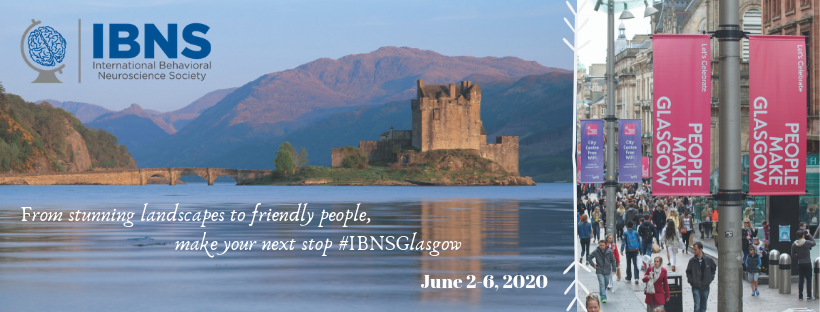
Back to Top
May Newsletter vol 23-7 Guest Editor:

Julianne Jett, Ph.D.
University of Texas Health San Antonio, USA
Thank you for volunteering your time
as Guest Editor, Julianne!
Interested in serving as a Guest Editor for the IBNS News?
Email: [email protected]
Back to Top
|